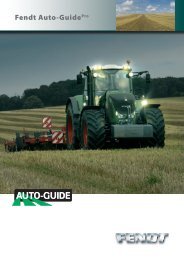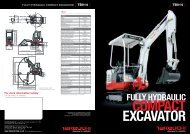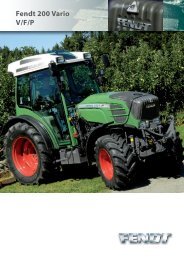Create successful ePaper yourself
Turn your PDF publications into a flip-book with our unique Google optimized e-Paper software.
When our company invests in<br />
production technology the aim<br />
is always planned effi ciency<br />
and cost savings. The focus is<br />
always on one thing and one<br />
thing alone: certainty of result.<br />
Reliable machinery that works<br />
well makes long term planning<br />
far easier. Why should it be any<br />
different in the milk and beef industries?<br />
<strong>SILOKING</strong> are specially<br />
designed to be accurate and<br />
reliable 365 days of the year.<br />
So it is easier to calculate the<br />
results and surprises are kept<br />
to a minimum.It is a proven<br />
fact that rearing calves out of<br />
doors in the fresh air in FLIX-<br />
BOX calf igloos has considerable<br />
fi nancial advantages. Simple<br />
operation and well thought out<br />
design are a sure basis for a<br />
good result and enable accurate<br />
calculations to be made.MAYER<br />
Tittmoning has built a fi rst class<br />
success story on this principle.<br />
But development never stops -<br />
why not join us?<br />
Best regards<br />
Georg Mayer<br />
MD MAYER Tittmoning<br />
www.siloking.com<br />
Feeding a cow means fi lling<br />
its stomach!<br />
Maximising genetic potential<br />
Throughout the world it is often the<br />
case that the genetic production potential<br />
of cows is hardly being used.<br />
The main opportunities for improvement<br />
are in feed. “Genetics are way<br />
ahead of our feeding habits”, and calf<br />
rearing and animal comfort come<br />
close behind.<br />
These cows with potential still depend<br />
on a suitable supply of protein and energy<br />
from feed containing appropriate<br />
mix. We have ever higher expectations<br />
of feed mixes and recipes<br />
Feeding a cow means fi lling its<br />
stomach<br />
A cow being a ruminant obtains at<br />
least 70% of its nutrients from its stomach<br />
where bacteria have to break<br />
down fi brous materials, protein and<br />
carbohydrates through fermentation<br />
to make it available to the cow. Special<br />
bacteria cultures in each feed component<br />
develop within 3 to 6 weeks and<br />
these operate effi ciently only in the<br />
specifi c feed. Consequently any chan-<br />
ge in the components in the feed disturbs<br />
the work of the bacteria for several<br />
weeks until fresh cultures have<br />
become established. So Rule No 1 is:<br />
The same components every day, the<br />
same recipe every day. Never change<br />
the recipe except when they are dry.<br />
Every mouthful the same<br />
If you want to ensure the cow eats all<br />
<strong>SILOKING</strong> Vertical Feed Mixers mechanise feeding and optimise the process.<br />
the ingredients in the feed recipe the<br />
best feed is mixed feed. This is a development<br />
from the USA which can be<br />
matched to local feed requirements<br />
anywhere in the world. The feed is<br />
mixed in a Feed Mixer with a weighing<br />
system. But cows are connoisseurs<br />
too and try to pick out the tastier ingredients<br />
from the feed. You can avoid<br />
this by ensuring the feed is moist<br />
enough and does not suffer from an<br />
excess of long fi bres. So Rule No 2<br />
is: Nothing in the feed should be<br />
longer than the width of the cow’s<br />
mouth.<br />
Don’t lose the structured texture<br />
At the same time the feed needs struc-<br />
Good dairy cows ruminate for six or seven hours a day and produce about 250<br />
litres of saliva.










